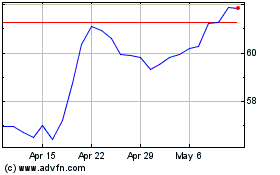Bank's stock sinks in wake of enforcement action, wiping out $29
billion in market value
By Emily Glazer
This article is being republished as part of our daily
reproduction of WSJ.com articles that also appeared in the U.S.
print edition of The Wall Street Journal (February 6, 2018).
A selloff in Wells Fargo & Co. shares chopped $29 billion
from the bank's market value after the Federal Reserve cast it into
a regulatory purgatory and limited its ability to expand its
business.
Shares tumbled 9.2% on Monday amid a broader selloff in stock
prices, as analysts ratcheted down earnings estimates for the
third-largest U.S. bank by assets. The decline, its sharpest
one-day drop since April 2009, was especially painful because the
recently bright outlook for banks was also thrown into question
Monday.
The acute market declines shifted, at least for now, bank
investors' optimism about stronger economic growth, rising interest
rates and lighter regulation. The KBW Nasdaq Bank Index dropped
4.9%, slightly more than the 4.6% decline in the Dow Jones
Industrial Average.
Still, Wells Fargo has been hit the hardest. Since the start of
the year, Wells Fargo's shares have lost 4.2%, while its biggest
peers have gained between 2% and 3%.
Meanwhile, the bank's price/earnings ratio has fallen below that
of JPMorgan Chase & Co. and Bank of America Corp.
The challenge now facing Wells Fargo was on display Friday night
in an analyst call held less than two hours after the Fed announced
an unprecedented enforcement action and said the bank would replace
four board directors by year-end.
Chief Executive Officer Timothy Sloan said five times on the
call that the bank is "open for business."
Wells Fargo in its presentation to analysts Friday night said
that it expected the Fed action to reduce 2018 after-tax profit by
between $300 million and $400 million.
Such a reduction comes at an inopportune time for Wells Fargo.
Over the past three quarters, the bank's net interest income -- a
gauge of lending profitability -- has fallen. At the same time, the
bank has been in the midst of an effort to cut $4 billion in annual
costs by 2019.
In the wake of the Fed's growth cap, half a dozen analysts on
Monday cut estimates for 2018 earnings per share to an average of
$4.71 from a previous average of $4.83. Some of those analysts
trimmed forecasts for 2019 earnings to an average of $5.16, down
from an average of $5.40.
KBW bank analyst Brian Kleinhanzl downgraded Wells Fargo to
"market perform" from "outperform" and lowered his 2018 earnings
per share estimates to $4.70 from $4.90 and for 2019 to $5.10 from
$5.45.
"The bottom line is that the [Fed] order will mean Wells will
have a harder time maintaining market share and will have to
compete more on price or credit terms versus peers," he wrote.
Gerard Cassidy, an RBC Capital bank analyst, also voiced
concerns about competition, writing that "existing customers could
be pried away from the company by aggressive competitors." He added
that given a positive outlook for the banking industry, investors
would be better off owning JPMorgan, Bank of America or Citigroup
Inc., which "will be able to harness the growth of the U.S.
economy."
Wells Fargo executives said Friday that they would use a series
of financial maneuvers to limit certain activities so the bank
won't have to deny business to its large consumer base. But certain
commercial customers could get squeezed.
For instance, the bank may reduce certain commercial deposits
known as "nonoperational," of which it had roughly $200 billion as
of the end of 2017. That is a tactic JPMorgan used to lower its
asset size a few years ago.
Wells Fargo may also limit financial institutions' deposits,
which tallied $149 billion at year-end 2017. And it could also
reduce its $92 billion in trading assets and $91 billion in
short-term investments as of Dec. 31, 2017.
Some analysts were more sanguine. Sanford C. Bernstein's John
McDonald wrote Monday that the growth cap will be manageable
because Wells Fargo "was already planning to continue
shrinking...auto and home-equity loans." He estimates the two
noncore portfolios will decline by about $15 billion this year,
"creating additional flexibility" for the bank.
Overall, Mr. McDonald said he expects the impact of the Fed
moves to go away by next year. He added the growth cap hadn't
significantly altered his view of the bank, but he had been
modeling just 1% loan growth in 2018.
Some investors were taken aback by the Fed's action and the fact
the bank hasn't fully overcome the sales-practices scandal. Still,
others were holding on.
Shareholder David Katz said the Fed's action is "sending another
message to Wells that they've got to be more aggressive in getting
their act together." But he said he was confident in the bank's
approach to how it can "meet all the needs" of clients and manage
the balance sheet.
Mr. Katz, who is president and chief investment officer at New
York-based Matrix Asset Advisors Inc. that owns about 480,000 Wells
Fargo shares, said the firm plans to hold its current position.
Shareholder Bill Smead said he wasn't happy about the bank's
growth restrictions. But Mr. Smead, CEO of Seattle-based Smead
Capital Management, also wasn't planning to sell any of his firm's
roughly $78 million of Wells Fargo shares because "we haven't been
losing money while we waited [for the bank to recover]...it's just
been on a continuous march."
Write to Emily Glazer at emily.glazer@wsj.com
(END) Dow Jones Newswires
February 06, 2018 02:47 ET (07:47 GMT)
Copyright (c) 2018 Dow Jones & Company, Inc.
Wells Fargo (NYSE:WFC)
Historical Stock Chart
From Mar 2024 to Apr 2024

Wells Fargo (NYSE:WFC)
Historical Stock Chart
From Apr 2023 to Apr 2024
